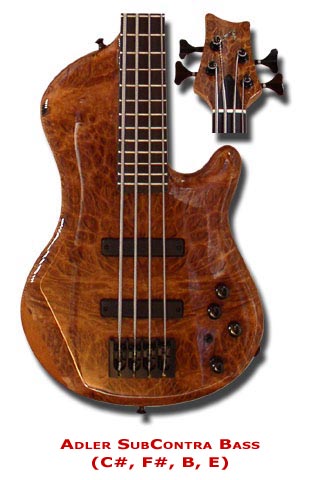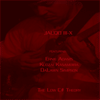![]()
 BASS - The word itself embodies low, foundation, depth, bottom, thickness, etc. The question that is most asked is "how low can one go." Well, for now, we shall touch on the basics of the electric basses' low frequencies. For decades we had the four string electric bass tuned G, D, A, & E, high to low. The concept of low frequency has existed far longer than the instrument itself. But, we are viewing a commercial approach to electric bass (Fender, Rickenbacker, Gibson, etc.). Michael Henderson was one of the first to use the dropped D - tuning (with Miles). Then, there's Anthony Jackson, actually bringing to the electric bass, another string. (The Fender six string Bass was actually a baritone guitar). Lower than the standard E, which logically would be a B. Oh, it was the biggest joke for some, but Anthony stuck to his vision and in doing so the low B has become standard (thanks to Jimmy Johnson as well for being one of the earliest proponents of the low B string's possibilities). Anthony added the high C string, which would be logical since it is a bass (low frequency) version of the guitar.
BASS - The word itself embodies low, foundation, depth, bottom, thickness, etc. The question that is most asked is "how low can one go." Well, for now, we shall touch on the basics of the electric basses' low frequencies. For decades we had the four string electric bass tuned G, D, A, & E, high to low. The concept of low frequency has existed far longer than the instrument itself. But, we are viewing a commercial approach to electric bass (Fender, Rickenbacker, Gibson, etc.). Michael Henderson was one of the first to use the dropped D - tuning (with Miles). Then, there's Anthony Jackson, actually bringing to the electric bass, another string. (The Fender six string Bass was actually a baritone guitar). Lower than the standard E, which logically would be a B. Oh, it was the biggest joke for some, but Anthony stuck to his vision and in doing so the low B has become standard (thanks to Jimmy Johnson as well for being one of the earliest proponents of the low B string's possibilities). Anthony added the high C string, which would be logical since it is a bass (low frequency) version of the guitar.
Then we flashed forward. There's a little buzz going around about an electric bass going lower than the Contra Bass (a six string version of the four string). What we got was the low F# string, a note lower than the already low B. Thank you Bill Dickens. While on my conceptional journey of a string lower than Anthony's low B, I had no idea that Bill Dickens was already utilizing his low F# string. In being informed of Billy's dedicated conviction to its development, it was now reinforced upon my soul that it was possible (talk about the biggest smile). So my concept of the low C# was in high gear. One of the first persons I mentioned this to was Bill Dickens. I cannot put into words the magnitude of his belief and support. The first and only luthier I brought my concept to was Scott Surine of Surine Electric Basses who gave it some thought and thanks to his open mindedness and the help of his partner, Scott Loftquest, we were on our way. But strings, pickups and electronics were now in question. My attitude was - and still to this day is - with today's technology, why not? I then gave my friends, Pat and Bill Bartolini of Bartolini Pickups and Electronics, a call. Bill's reaction was like a kid on his way to his very own birthday party. We went straight to it. It wasn't overnight, but truth in patience was reinforced. Strings, wow! So I went to the company that was already there for me. To make a long, interesting, and bonding journey short, I would just like to thank Dave Lionhardt, Mike Connolly, Jeff Landtroop, and David Brummett at Dean Markley Strings. So through idea, (Ornette once told me that without the idea I couldn't have the concept) concept, theory, trial and errors, the SubContra Bass tuned E, B, F#, and C# high to low was now a reality. (Its name derives from frequencies lower than the Contra Bass.) The seed behind the concept of the SubContra Bass was that grooving with a string lower than a low B would be so much more spiritual for me. (The lower the frequency the more it moves through one's body, almost like a whole new blood stream traveling side by side with the blood that's already in motion.) The tighter the groove with the lowest possible frequency would be second only to heaven sent.
I'm currently in rehearsal mode with my band, the Jauqo III-X Reality, utilizing the SubContra Bass. From there we will be going into recording. I would like to thank Anthony Jackson, Bill Dickens, Scott Surine, Scott Loftquest, all the Kats at Dean Markley Strings, Pat and Bill Bartolini, and the higher being for allowing me to stay true to my vision.
Jauqo III-X

Makers of Jauqo's Low C# String and Jauqo's signature series strings.

Makers of the the worlds first Sub contra bass

Mike Adler maker of Jauqo III-X fretless SubContra Bass

Makers of the Jauqo III-X SubContra Bass

